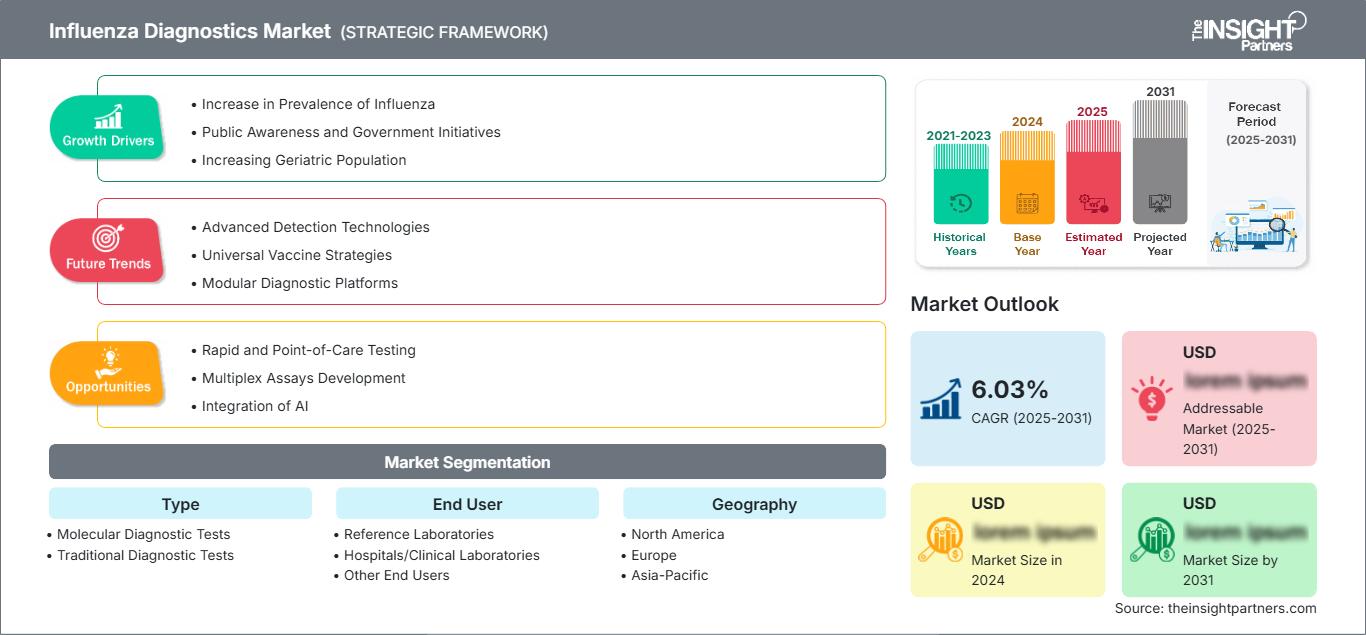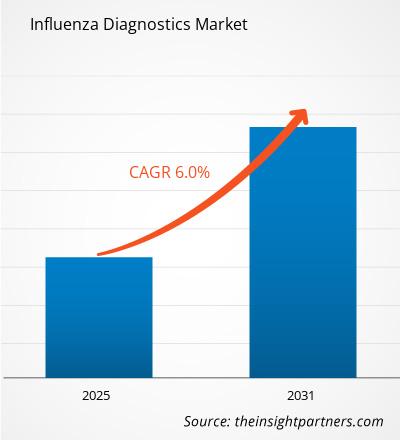Se espera que el tamaño del mercado de diagnóstico de influenza alcance los US$ 2.3 mil millones para 2031. Se anticipa que el mercado registre una CAGR del 6,7% durante 2025-2031.
El informe está segmentado por tipo (Pruebas de Diagnóstico Molecular, Pruebas de Diagnóstico Tradicionales) y usuario final (Laboratorios de Referencia, Hospitales/Laboratorios Clínicos, Otros Usuarios Finales). El análisis global se desglosa a nivel regional y por países principales. El informe ofrece el valor en USD para el análisis y los segmentos mencionados.
Propósito del Informe
El informe "Mercado de Diagnóstico de Influenza" de The Insight Partners busca describir el panorama actual y el crecimiento futuro, los principales factores impulsores, los desafíos y las oportunidades. Esto proporcionará información a diversas partes interesadas del negocio, como:
- Proveedores/fabricantes de tecnología: Para comprender la dinámica cambiante del mercado y conocer las oportunidades potenciales de crecimiento, lo que les permitirá tomar decisiones estratégicas informadas.
- Inversores: Realizar un análisis exhaustivo de tendencias respecto a la tasa de crecimiento del mercado, las proyecciones financieras del mercado y las oportunidades que existen en toda la cadena de valor.
- Órganos reguladores: Regular las políticas y las actividades policiales en el mercado con el objetivo de minimizar el abuso, preservar la confianza de los inversores y defender la integridad y estabilidad del mercado.
Segmentación del mercado de diagnóstico de influenza
- Pruebas de diagnóstico molecular
- Pruebas de diagnóstico tradicionales
Usuario final
- Laboratorios de referencia
- Hospitales/Laboratorios Clínicos
- Otros usuarios finales
Obtendrá personalización en cualquier informe, sin cargo, incluidas partes de este informe o análisis a nivel de país, paquete de datos de Excel, así como también grandes ofertas y descuentos para empresas emergentes y universidades.
Mercado de diagnóstico de influenza: perspectivas estratégicas

- Obtenga las principales tendencias clave del mercado de este informe.Esta muestra GRATUITA incluirá análisis de datos, desde tendencias del mercado hasta estimaciones y pronósticos.
Factores que impulsan el crecimiento del mercado de diagnóstico de la influenza
- Aumento de la prevalencia de la influenza: En 2021, los Centros para el Control y la Prevención de Enfermedades (CDC) informaron que 9 millones de pacientes se vieron afectados por la influenza. Según las actualizaciones de febrero de 2021 de la Organización Mundial de la Salud (OMS), los laboratorios del SMVRG de la OMS analizaron más de 490 516 muestras entre 2021 y 2022. El aumento de casos de influenza en la población mundial está impulsando la demanda de herramientas de diagnóstico para la detección y prevención de la enfermedad.
- Concientización pública e iniciativas gubernamentales: Una mayor concientización sobre la influenza mediante campañas de salud patrocinadas por el gobierno aumentará la importancia de la detección temprana, lo que resultará en que más pacientes busquen tratamiento. Esto, a su vez, fomenta la demanda de diagnósticos de influenza.
- Aumento de la población geriátrica: El enorme crecimiento de la población de edad avanzada impulsa el mercado de diagnóstico de la gripe. Los adultos mayores son propensos a sufrir complicaciones por la gripe, por lo que se observa una mayor demanda de pruebas diagnósticas para el tratamiento de su afección.
Tendencias futuras del mercado de diagnóstico de influenza
- Tecnologías de detección avanzadas: Los futuros diagnósticos de influenza desarrollados con estrategias de detección más sofisticadas, incluidas la secuenciación de próxima generación y las tecnologías genómicas, harán posible una mayor sensibilidad y especificidad, lo que permitirá la identificación más rápida de los virus de influenza específicos involucrados, siendo así de mucho más apoyo para diseñar tratamientos adecuados para las enfermedades y controlar los brotes.
- Estrategias universales de vacunación: Si bien la elaboración de vacunas panvirales se centrará principalmente en el desarrollo de vacunas, las nuevas tecnologías podrían influir en el diagnóstico. Estas vacunas son más eficaces para atacar los componentes conservados de los virus y, por lo tanto, pueden contribuir a una mejor identificación de las cepas de gripe que se utilizarían para modificar las pruebas diagnósticas.
- Plataformas de diagnóstico modulares: Las futuras plataformas de diagnóstico deberán desarrollarse con la capacidad de adaptarse rápidamente a cepas de influenza u otros virus respiratorios, entre otros. Esta adaptabilidad debería permitir responder con una rapidez sin precedentes a las actualizaciones del sistema de salud ante las amenazas emergentes.
Oportunidades de mercado para el diagnóstico de la influenza
- Pruebas rápidas y en el punto de atención: El desarrollo de pruebas de diagnóstico rápido que puedan utilizarse en el punto de atención generaría oportunidades de crecimiento lucrativas en el mercado del diagnóstico de la influenza. Estas pruebas ayudarán a los profesionales de la salud a diagnosticar la influenza con mayor rapidez en clínicas, salas de urgencias y otros entornos, lo que permitirá un tratamiento rápido y minimizará la propagación del virus.
- Desarrollo de ensayos multiplex: Los diagnósticos futuros podrían incluir ensayos multiplex que detecten simultáneamente múltiples patógenos respiratorios, entre ellos varios subtipos de influenza. Esto optimizará los procesos de prueba y mejorará la eficiencia general del diagnóstico en casos de enfermedades respiratorias, creando oportunidades para los actores del mercado.
- Integración de la IA: El papel de la IA y el aprendizaje automático en el diagnóstico de la gripe será de gran ayuda para obtener resultados más precisos y rápidos. Las tecnologías en este sentido permiten analizar grandes conjuntos de datos, identificando los patrones predominantes y prediciendo brotes, lo que fortalece la respuesta contra la amenaza de la gripe.
Perspectivas regionales del mercado de diagnóstico de influenza
Los analistas de The Insight Partners han explicado detalladamente las tendencias regionales y los factores que influyen en el mercado de diagnóstico de influenza durante el período de pronóstico. Esta sección también analiza los segmentos y la geografía del mercado de diagnóstico de influenza en América del Norte, Europa, Asia Pacífico, Oriente Medio y África, y América del Sur y Central.
Alcance del informe de mercado de diagnóstico de la influenza
| Atributo del informe | Detalles |
|---|---|
| Tamaño del mercado en 2024 | XX mil millones de dólares estadounidenses |
| Tamaño del mercado en 2031 | 2.300 millones de dólares estadounidenses |
| CAGR global (2025-2031) | 6,7% |
| Datos históricos | 2021-2023 |
| Período de pronóstico | 2025-2031 |
| Segmentos cubiertos | Por tipo
|
| Regiones y países cubiertos | América del norte
|
| Líderes del mercado y perfiles de empresas clave |
|
Densidad de actores del mercado de diagnóstico de influenza: comprensión de su impacto en la dinámica empresarial
El mercado de diagnóstico de influenza está creciendo rápidamente, impulsado por la creciente demanda del usuario final debido a factores como la evolución de las preferencias de los consumidores, los avances tecnológicos y un mayor conocimiento de los beneficios del producto. A medida que aumenta la demanda, las empresas amplían su oferta, innovan para satisfacer las necesidades de los consumidores y aprovechan las tendencias emergentes, lo que impulsa aún más el crecimiento del mercado.

- Obtenga una descripción general de los principales actores clave del mercado de diagnóstico de influenza
Puntos clave de venta
- Cobertura integral: el informe cubre de manera integral el análisis de productos, servicios, tipos y usuarios finales del mercado de diagnóstico de influenza, proporcionando un panorama holístico.
- Análisis de expertos: el informe se compila con base en el conocimiento profundo de expertos y analistas de la industria.
- Información actualizada: El informe asegura relevancia comercial debido a su cobertura de información reciente y tendencias de datos.
- Opciones de personalización: este informe se puede personalizar para satisfacer los requisitos específicos del cliente y adaptarse adecuadamente a las estrategias comerciales.
Por lo tanto, el informe de investigación sobre el mercado de diagnóstico de la influenza puede ayudar a descifrar y comprender el panorama de la industria y sus perspectivas de crecimiento. Si bien existen algunas preocupaciones válidas, las ventajas generales de este informe tienden a superar las desventajas.
- Análisis histórico (2 años), año base, pronóstico (7 años) con CAGR
- Análisis PEST y FODA
- Tamaño del mercado, valor/volumen: global, regional y nacional
- Industria y panorama competitivo
- Conjunto de datos de Excel
Informes recientes
Testimonios
Razón para comprar
- Toma de decisiones informada
- Comprensión de la dinámica del mercado
- Análisis competitivo
- Información sobre clientes
- Pronósticos del mercado
- Mitigación de riesgos
- Planificación estratégica
- Justificación de la inversión
- Identificación de mercados emergentes
- Mejora de las estrategias de marketing
- Impulso de la eficiencia operativa
- Alineación con las tendencias regulatorias




















 Obtenga una muestra gratuita para - Mercado de diagnóstico de la influenza
Obtenga una muestra gratuita para - Mercado de diagnóstico de la influenza